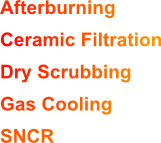



Caldo Consultants have experience of many hot gas treatment processes
Email Caldo at caldo@caldo.com; phone on +44 (0)1562 861952
Complete Pollution Control Systems
Regulated Emissions to Atmosphere
Waste gases are often hot and, if they contain fume or dust, Caldo hot gas filters can be used to remove these solids before the gases are released to atmosphere. However, such gases often also contain other pollutants; ceramic filtration can be combined with other techniques to ensure that all of the controlled substances stay within regulatory limits.
Typical waste gases can contain the following classes of pollutants:
- particulates, such as dust, fume, heavy metals and condensed salts
- acid gases, such as SOx, HCl and HF
- oxides of nitrogen, NOx, produced in many high temperature processes
- products of incomplete combustion, VOCs and CO;
- the ingredients for the formation of 'de novo' dioxins and furans.
With one or two minor exceptions all of these can be controlled / removed by equipment based around a hot gas filter.
The emission of particulates is prevented by passing the gas through a ceramic filter.The filter is at the heart of all the pollution control systems supplied by Caldo. The particulate removal efficiency of ceramic filters greatly exceeds all regulatory requirements.
Dry Scrubbing
A major category of regulated pollutants is acid gases as listed above. In the atmosphere these gases dissolve in water to produce the acid rain which is so harmful to the natural environment.
Dry scrubbing is a technique for removing components from a gas by reacting them with a solid and then filtering the gas to remove the solid. For acid gas removal there is a choice of reactive solids between sodium bicarbonate and hydrated calcium oxide (Ca(OH)2 – commonly called called lime); sodium bicarbonate works best at lower temperatures whereas lime is substantially cheaper.
Caldo has pioneered the use of lime at a higher temperature, 400 degC, in conjunction with ceramic filtration to remove it from the gas stream. Operation at this temperature greatly increases the acid gas removal efficiency, reducing operating costs to a minimum.
Caldo has developed a powder feeder for controlling the addition of lime to the gas stream. This compact unit can be sited in a convenient location and it will blow the the metered amount of lime through a small diameter pipe into the inlet duct to the filter.
Secondary Combustion
- particulates, such as dust, fume, heavy metals and condensed salts
- acid gases, such as SOx, HCl and HF
- oxides of nitrogen, NOx, produced in many high temperature processes
- products of incomplete combustion, VOCs and CO;
- the ingredients for the formation of 'de novo' dioxins and furans.
With one or two minor exceptions all of these can be controlled / removed by equipment based around a hot gas filter.
The emission of particulates is prevented by passing the gas through a ceramic filter.The filter is at the heart of all the pollution control systems supplied by Caldo. The particulate removal efficiency of ceramic filters greatly exceeds all regulatory requirements.
Dry Scrubbing
A major category of regulated pollutants is acid gases as listed above. In the atmosphere these gases dissolve in water to produce the acid rain which is so harmful to the natural environment.
Dry scrubbing is a technique for removing components from a gas by reacting them with a solid and then filtering the gas to remove the solid. For acid gas removal there is a choice of reactive solids between sodium bicarbonate and hydrated calcium oxide (Ca(OH)2 – commonly called called lime); sodium bicarbonate works best at lower temperatures whereas lime is substantially cheaper.
Caldo has pioneered the use of lime at a higher temperature, 400 degC, in conjunction with ceramic filtration to remove it from the gas stream. Operation at this temperature greatly increases the acid gas removal efficiency, reducing operating costs to a minimum.
Caldo has developed a powder feeder for controlling the addition of lime to the gas stream. This compact unit can be sited in a convenient location and it will blow the the metered amount of lime through a small diameter pipe into the inlet duct to the filter.
Secondary Combustion
Also known as afterburning, this is generally the first operation performed on the waste gas. It is done in order to complete the combustion of volatile organic compounds (VOCs) and carbon monoxide (CO) that may remain after the initial burning. It involves heating the gas to 850 degC in the presence on at least 6% of oxygen for a period of at least 2 seconds.
In the past the supplier of the primary combustion stage often also produced the secondary. Increasingly, however, Caldo is being asked to supply complete pollution control systems, including the afterburner. We now supply gas or oil fired afterburners to our own design with a choice of refractory linings.
NOx Removal
Dry scrubbing is insufficiently effective for NOx removal and an alternative technique, selective non-
The technical challenge for Caldo was to identify and engineer a system for delivering the NH3 safely and effectively into the process. Ammonia is a toxic chemical, dangerous to ship and store so Caldo sought an alternative. Fortunately a common fertiliser, urea, is soluble in water, decomposes to ammonia when heated and is available as a prilled solid, very safe to handle and ship. Caldo developed the equipment to dissolve the prills in water and spray the solution into the process gas at a controlled pressure.
Data Sheets
Data sheets about ceramic filters, ceramic filter elements, reverse pulse cleaning and other topics are available for downloading on the literature page.
| Photos |
| Glossary |